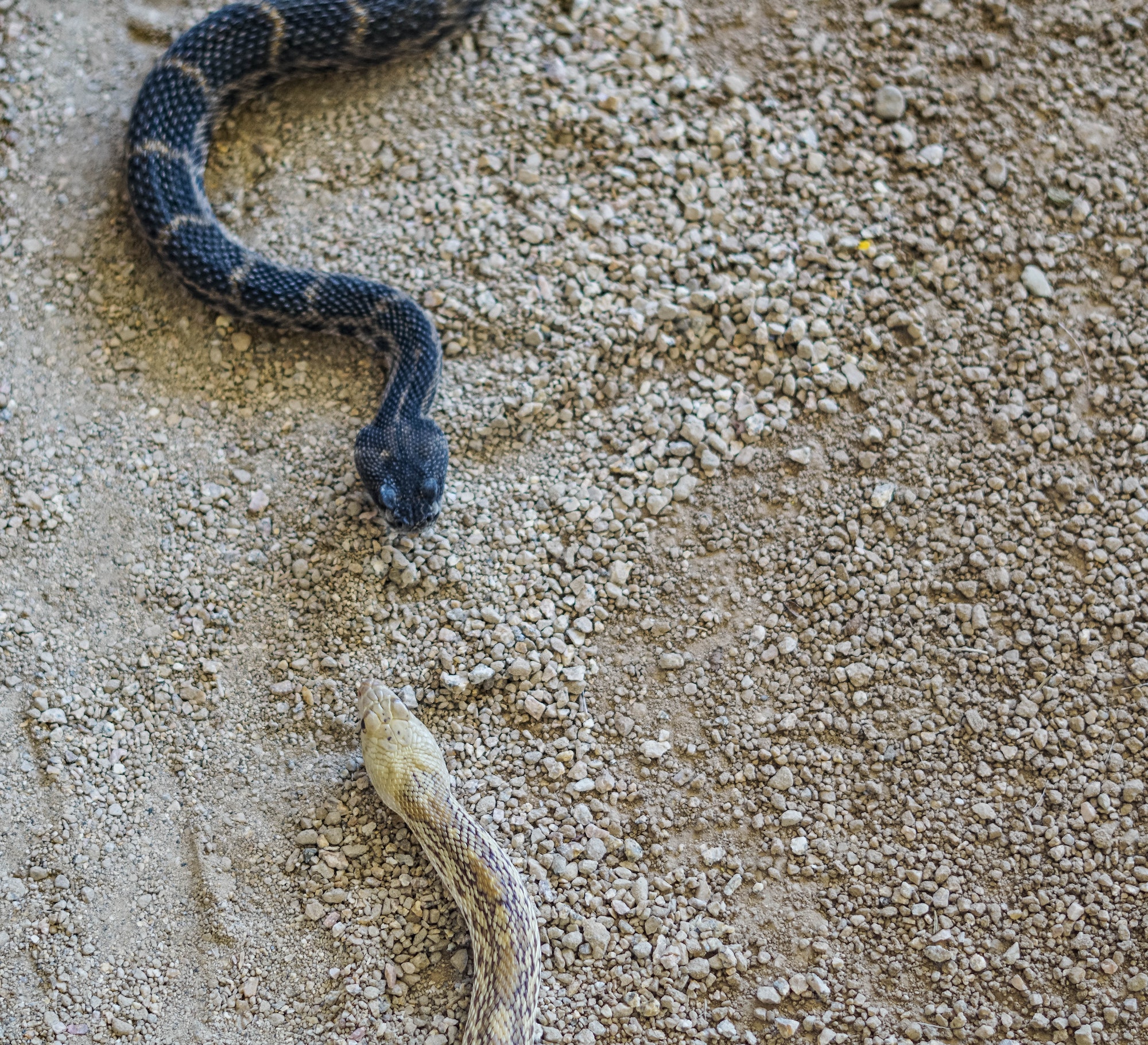Black Snakes & Copperheads: Imagine the thrill of witnessing a black snake pouncing on a venomous copperhead, asserting its dominance in the world of slithering creatures! In South Carolina and North Carolina, this spectacle is fascinating and plays a crucial role in maintaining balance within ecosystems. This article dives deep into the riveting relationships between black snakes, rattlesnakes, and copperheads and how black snakes’ predatory behavior influences their venomous counterparts’ lives. Get ready to be amazed as we unravel the secrets of these snakes and the environmental factors that shape their interactions!
Battle of the Snakes: Ecological Relationships and Interactions:
Black snakes, such as the sleek Eastern ratsnake (Pantherophis alleghaniensis) and the lightning-fast black racer (Coluber constrictor), are the unsung heroes in keeping venomous snake populations in check. Feasting on fearsome foes like the Eastern diamondback rattlesnake (Crotalus adamanteus) and the cunning copperhead (Agkistrodon contortrix), black snakes help maintain equilibrium in the ecosystem by acting as natural predators.
Distribution, Abundance, and Behavior: The Ultimate Snake Showdown
When black snakes slither into the scene, rattlesnakes and copperheads know they must tread carefully. The mere presence of black snakes can push venomous snakes to seek refuge in less suitable habitats, resulting in dwindling population sizes and a more challenging time finding mates. Furthermore, rattlesnakes and copperheads may become more cautious, altering their hunting patterns to avoid becoming a black snake’s next meal.
The Good, the Bad, and the Slithery: Pros and Cons of Black Snakes as Natural Predators
Black snakes are more than just thrilling creatures to observe – they also offer tangible benefits by keeping venomous snake populations under control. Fewer rattlesnakes and copperheads mean fewer snakebites and fatalities, making the outdoors safer for humans. Moreover, a balanced snake population contributes to a stable ecosystem where each species plays its part.
However, there’s a dark side to black snakes’ predatory prowess. Over-predation may lead to a decline in venomous snake populations, which can have cascading effects on the ecosystem. As vital controllers of rodent populations, a decrease in rattlesnakes and copperheads may result in a rodent explosion, with increased crop damage and disease spread.
Environmental Factors: The Serpentine Plot Thickens
Numerous environmental factors come into play in this fascinating snake drama. Habitat availability and fragmentation are critical in determining where these slippery creatures can coexist. With urbanization, agriculture, and deforestation on the rise, suitable habitats for black snakes, rattlesnakes, and copperheads are becoming scarcer. Moreover, these slithering species may even compete for the same food resources, such as rodents and other small mammals, adding more intrigue to their relationships.
The amazing world of black snakes preying on venomous snakes like copperheads is an enthralling tale that sheds light on the complex relationships and interactions within their ecosystems. As we marvel at the predatory prowess of black snakes, it’s essential to recognize the potential consequences and the environmental factors that influence these interactions. Continued research and monitoring are crucial to ensure the long-term health of snake populations, and who knows – you might catch a glimpse of a black snake devouring a copperhead in the wild!
FAQ
Q: What species of black snakes are commonly found in South Carolina and North Carolina?
A: The Eastern ratsnake (Pantherophis alleghaniensis) and the black racer (Coluber constrictor) are commonly found in these states.
Q: What venomous snakes are black snakes known to prey upon?
A: Black snakes are known to prey upon the Eastern diamondback rattlesnake (Crotalus adamanteus) and the copperhead (Agkistrodon contortrix).
Q: How do black snakes influence the distribution and behavior of venomous snakes?
A: Black snakes may force venomous snakes to occupy less suitable habitats, leading to reduced population sizes and altered foraging patterns due to increased vigilance.
Q: What are the benefits of black snakes acting as natural predators?
A: Black snakes can help reduce negative human-snake encounters by controlling venomous snake populations and contribute to a more stable ecosystem by maintaining the balance in the food web.
Q: What are the drawbacks of black snakes acting as natural predators?
A: Over-predation may lead to a decline in venomous snake populations, which can result in an increase in rodent populations, leading to crop damage and the spread of diseases.
Q: How do environmental factors impact the interactions between black snakes and venomous snakes?
A: Habitat availability, fragmentation, and prey availability are key factors that can influence the interactions and competition between these snake species.
List of Facts:
- Black snakes, including the Eastern ratsnake and black racer, are known predators of venomous snakes like the Eastern diamondback rattlesnake and the copperhead.
- The presence of black snakes can force venomous snakes to occupy less suitable habitats, resulting in reduced population sizes and decreased reproductive success.
- Predation by black snakes may cause venomous snakes to exhibit increased vigilance and alter their foraging patterns.
- Black snakes can indirectly contribute to a decrease in snakebites and associated fatalities by controlling venomous snake populations.
- A decline in venomous snake populations due to over-predation by black snakes may lead to increased rodent populations, causing crop damage and the spread of diseases.
- Habitat availability, fragmentation, and prey availability are key environmental factors that influence the interactions between black snakes and venomous snakes.
- Suitable habitats for black snakes, rattlesnakes, and copperheads are becoming increasingly limited due to urbanization, agriculture, and deforestation.
- Black snakes, rattlesnakes, and copperheads may compete for the same food resources, such as rodents and other small mammals.




